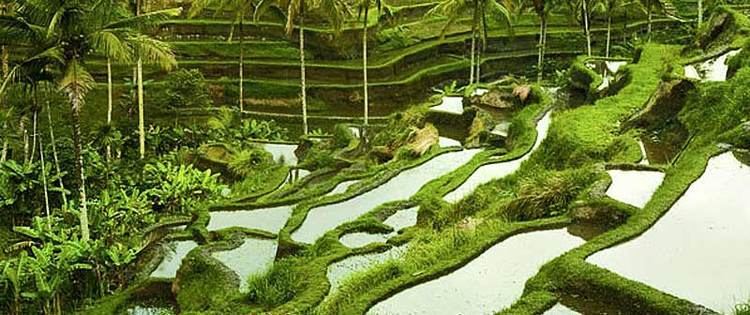Time zone UTC+08 | Regency Gianyar Local time Thursday 9:30 PM | |
 | ||
Weather 26°C, Wind W at 5 km/h, 87% Humidity Points of interest Ubud Monkey Forest, Goa Gajah, Blanco Renaissance Museum, Agung Rai Museum of Art, Neka Art Museum | ||
10 things to do in ubud
Ubud is a town on the Indonesian island of Bali in Ubud District, located amongst rice paddies and steep ravines in the central foothills of the Gianyar regency. Promoted as an arts and culture centre, it has developed a large tourism industry.
Contents
- 10 things to do in ubud
- Map of Ubud Gianyar Bali Indonesia
- History
- Streets
- Buildings
- Economy
- Culture
- Nature
- References
Map of Ubud, Gianyar, Bali, Indonesia
Ubud has a population of about 30,000 people. It can be difficult for visitors to distinguish the town itself from the 13 villages that surround it. The area surrounding the town is made up of small farms, rice paddies, and dense forest.
History
Eighth-century legend tells of a Javanese priest, Rsi Markendya, who meditated at the confluence of two rivers (an auspicious site for Hindus) at the Ubud locality of Campuan. Here he founded the Gunung Lebah Temple on the valley floor, the site of which remains a pilgrim destination.
The town was originally important as a source of medicinal herbs and plants; Ubud gets its name from the Balinese word ubad (medicine).
In the late nineteenth century, Ubud became the seat of feudal lords who owed their allegiance to the king of Gianyar, at one time the most powerful of Bali's southern states. The lords were members of the Balinese Kshatriya caste of Sukawati, and were significant supporters of the village's increasingly renowned arts scene.
Tourism on the island developed after the arrival of Walter Spies, an ethnic German born in Russia who taught painting and music, and dabbled in dance. Spies and foreign painters Willem Hofker and Rudolf Bonnet entertained celebrities including Charlie Chaplin, Noël Coward, Barbara Hutton, H.G. Wells and Vicki Baum. They brought in some of the greatest artists from all over Bali to teach and train the Balinese in arts, helping Ubud become the cultural centre of Bali.
A new burst of creative energy came in the 1960s after the arrival of Dutch painter Arie Smit (b. 1916) and the development of the Young Artists Movement.
The Bali tourist boom since the late 1960s has seen much development in the town; however, it remains a centre of artistic pursuit.
Streets
The main street is Jalan Raya Ubud (Jalan Raya means main road), which runs east–west through the center of town. Two long roads, Jalan Monkey Forest and Jalan Hanoman, extend south from Jalan Raya Ubud.
Buildings
Puri Saren Agung is a large palace located at the intersection of Monkey Forest and Raya Ubud roads. The residence of Tjokorda Gede Agung Sukawati (1910–1978), the last ruling monarch of Ubud, it is still owned by the royal family. Dance performances and ceremonies are held in its courtyard. The palace was also one of Ubud's first hotels, opening its doors back in the 1930s.
A number of Hindu temples exist, such as Pura Desa Ubud, which is the main temple, Pura Taman Saraswati, and Pura Dalem Agung Padangtegal, the temple of death. The Gunung Kawi temple is the site of the royal tombs. Goa Gajah, also known as the Elephant Cave, is located in a steep valley just outside Ubud near the town of Bedulu.
The Moon of Pejeng, in nearby Pejeng, is the largest single-cast bronze kettle drum in the world, dating from circa 300BC. It is a popular destination for tourists interested in local culture.
Economy
The economy of Ubud is highly reliant on tourism which focuses on shopping, resorts, museums, and zoos. In contrast to the main tourist area in southern Bali, the Ubud area is less densely populated. A number of smaller boutique-style hotels such as the historic Tjampuhan Hotel are located in and around Ubud, where spa treatments, massage parlors, taxis, or treks up nearby mountains are commonly offered.
Culture
The town and area has a number of art museums, such as the Blanco Renaissance Museum, the Puri Lukisan Museum, Neka Art Museum, and the Agung Rai Museum of Art. Close-by is the Museum Rudana in Peliatan,
The Tek Tok is a traditional Balinese dance that is accompanied by musical sound of mouth 'Tek Tok' altogether with various combinations of body movement and other sounds. The story Draupadi Parwa told in the Tek Tok Dance tells a moral message, when a woman who embodies the values of patience, sacrifice, compassion, devotion, and holy sincerity is disrespected, then disasters and calamities will befall a kingdom or state. This story also conveys the message that truth, virtue, devotion and genuine compassion will always be protected by God. The Tek Tok dance performance is held regularly at the Bali Culture Center (BCC) in Ubud four times a week.
Nature
The Ubud Monkey Forest is a animal park located near the southern end of Jalan Monkey Forest. It houses the Pura Dalem Agung Padangtegal, and approximately 340 crab-eating macaque (Macaca fascicularis) monkeys live there.
The Campuhan ridge walk is a hill in nearby Campuhan, from where one can see two rivers, Tukad Yeh Wos Kiwa and Tukad Yeh Wos Tengen, merge. A one meter wide paved-block track runs about two kilometers to the top of the hill.
